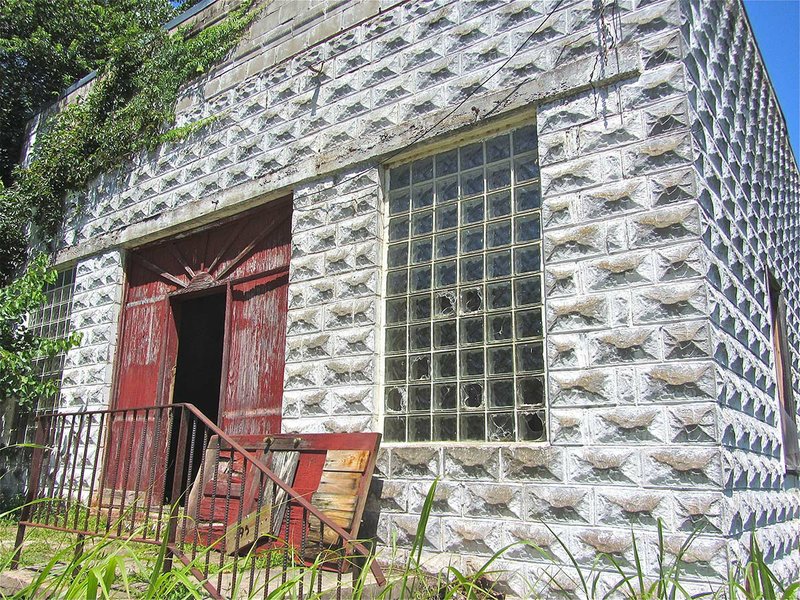CALICO ROCK -- A rustic wagon bridge across Calico Creek separates two historic parts of Calico Rock. Below is a ghost town of empty stores and other businesses, along with a pint-size jail. Above stands the current commercial strip, some of its weathered facades also dating back a century or more.
Both areas are shadowed by multi-hued White River bluffs that early settlers likened to colorful strips of calico cloth -- thus the place's beguiling name. Taken together, they steer visitors back to the early 1900s.
That was a time when the ongoing expansion of railroads brought at least passing prosperity to any number of Arkansas communities, including this Izard County settlement 140 miles north of Little Rock.
Although the trains are long gone, Calico Rock sustains a pulse not often found these days in the state's small towns. That's thanks in part to the efforts of the Calico Rock Organization for Revitalization. The local population has actually risen by more than 50 percent since the 2000 census, with a 2010 count of 1,545.
Main Street, which carries Arkansas 5 across the river, is still lined with a decent number of open businesses. Handsome newer homes, along with century-old houses, line nearby bluff tops. The White River and nearby Lake Norfork are popular venues for fishing and boating.
It makes sense to start a visit at Calico Rock Museum & Visitor Center, 104 Main St., which can supply brochures mapping out Main Street Historic District and East Calico Historic District. East Calico is touted as "the only authentic ghost town inside the city limits of a town in America" -- an arcane distinction, perhaps, but a distinction nonetheless.
The two dozen derelict buildings in East Calico are best viewed on foot. Although empty, they are still privately owned, and going inside is prohibited. Making this ghost-town walk livelier is a set of signs detailing the onetime use of the structures.
At Hall's Funeral Home, with its red doors ajar, "In the 1920s, the mortician and his wife lived in the back. He 'ran off,' but she continued to operate the business for the new owner, Mr. McGuire. In the 1950s, Roman and Wilma Howard lived here and ran the business for owner Lawrence Hall. After the mortician embalmed a body, the family would lay out the deceased at home for viewing."
The old city jail, about the size of a storage shed, was used until the 1950s. It "often held persons accused of public drunkenness or disturbing the peace. But most arrests were for fighting. Anywhere from two to 20 people might join the melee. Weapons included fists, knives, ax handles, baseball bats and/or guns."
Briefly the town marshal in the 1940s, according to another sign, was William Luther Harris, known as "Greasy Slim." The nickname came because this eccentric vagabond was greased up from blacksmith's work. He "avoided bathing or washing his clothes. Once a year, he bought a new shirt and bib overalls, which he put on over the old ones. He slept on a cot in the grist mill or on the floor of the jail."
On the fringe of East Calico, Peppersauce Alley owes its name to shanty taverns of the 1890s, where "barkeepers served 'peppersauce' -- the local name for home-brew -- to thieves and troublemakers. ... Knife fights, fistfights plus the odd stray bullet discouraged gentle folk from venturing into Peppersauce Alley."
Back at the museum, a walk-through exhibit replicates an 18th-century grass hut typical of those built by Osage Indians before the arrival of Europeans. Visitors also can stand at the wheel of the Ozark Queen and pretend to be a 19th-century riverboat captain. A recently opened gallery showcases work by members of the Calico Rock Artisan Cooperative.
The museum building was originally the Bank of Calico Rock, and visitors peering through a rear window can see the original teller cages. Another former bank building, now the office of Calico Rock-Pineville Chamber of Commerce, once housed the town's first public library, as well as medical offices and an artist's studio.
Overlooking the river is River View Hotel, in business since 1923. Its cheerful website promises that "we use only 100 percent cotton sheets, towels and other lines, and dry them in the sun on the clothesline out back. This is a mom and pop business. There's no business manager or receptionist."
That sounds like just about the right pace for Calico Rock.
For more information, call Calico Rock Museum & Visitor Center, (870) 297-6100 or visit calicorockmuseum.com. The museum is open 9 a.m.-5 p.m. Tuesday-Saturday, with no admission charge.
Scheduled for Sept. 12-13 in Calico Rock is the Mountain Man 2014 Rendezvous, featuring music on Main Street and storytelling in Rand Park.
River View Hotel can be contacted at (870) 297-8208 or ozarksriverview.com.
Weekend on 09/04/2014
